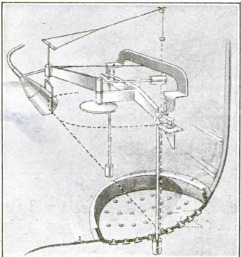The hydrophone, an instrument allowing to spot and trail submarines by sound
Contenuto
-
Titolo
-
The hydrophone, an instrument allowing to spot and trail submarines by sound
-
Article Title and/or Image Caption
-
Spotting and Trailing Submarines by Sound
-
extracted text
-
ON March 16, 1918, the French |
destroyer Dunois, under the com-
mand of Lieutenant Terreaux, was zig- |
zagging in the Channel between France
and Great Britain, searching for Ger-
man submarines. Shortly before one |
o'clock in the afternoon, a British
hydro-airplane, flying over the Dunois,
signaled that a hostile submarine was |
in close proximity. A listener was sent |
to the listening-chamber.
Twenty minutes later the listener
reported the sound of an explosion, |
probably the discharge of a torpedo |
which had missed the destroyer. By
means of the hydrophone, or listening |
apparatus, with which the Dunois was
equipped, the listener was able to
ascertain the direction from which the |
sound of the firing had come, and the
destroyer immediately started in pur-
suit of the submarine. |
A French Lieutenant's Invention
Shortly before half past four the
listener reported to the commander
that the Dunois had caught up with
the fleeing submarine and was right
over it. A depth-bomb was dropped. |
This exploded forty seconds later, and |
the submarine was disabled and soon
after sank.
The hydrophone, the invention of |
Georges Walser, a French naval lieu-
tenant, had stood its test, and the
French government equipped a large
number of destroyers with hydro-
phones of the Walser type. Their
success was remarkable.
On each side of the submarine
destroyer, well forward and near the
keel, large lens-shaped patches of steel,
bulging outward, are set over holes
cut in the hull for that purpose.
These patches have many perfora-
tions, which are closed by sensitive
vibrating plates. The patches form
large microphones, which collect the
sound waves traveling through the
water and transmit them to a receiv-
ing instrument in the interior of the
ship. The receiving apparatus is
placed in a sound-proof chamber
extending from one side of the ship to
the other between the two microphones.
A Wonderful Apparatus-
Each apparatus includes a sound-
collecting funnel, which is held by a
rotatable arm in such a position that
the opening of the funnel points to the
center of the microphone, while it
moves with the arm in a circular plane
within focal distance of the micro-
phone.
A pulley arrangement enables the
operator to move the sound-collecting
funnels at will to any part of the cir-
cumference of the microphones. The
sounds collected by the funnels are
transmitted by flexible tubes to the
listener's ear-pieces. The listener
moves the funnel to the point where
the sound can be heard most clearly,
and the marks of the scale on the
rim of the microphones, corresponding
to the position of the funnel, give him
the direction whence the sound-waves
come. The distance between the ship
and the source of the sound is caleu-
lated from the vibrations.
-
Autore secondario
-
Ernest Welleck (Article author)
-
Lingua
-
eng
-
Data di rilascio
-
1919-07
-
pagine
-
17
-
Diritti
-
Public domain (Google digitized)
-
Archived by
-
Davide Donà
-
Marco Bortolami (editor)





